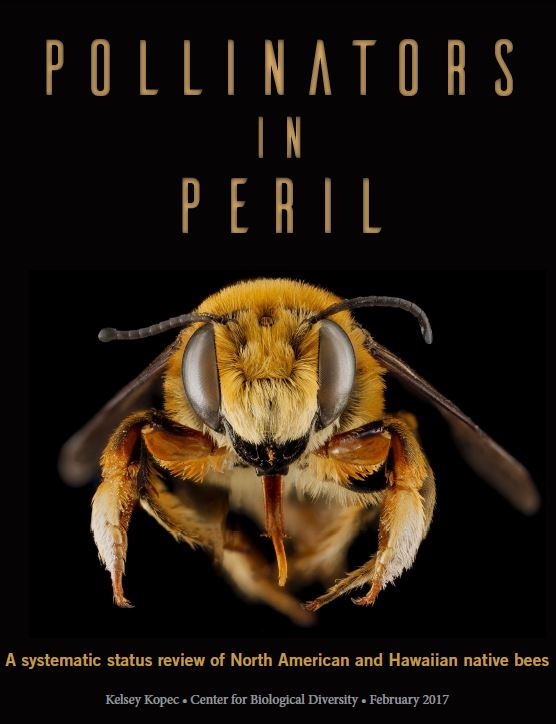Pollinators in Peril: A New Study from the Center for Biological Diversity
Nearly 1 in 4 native bee species are imperiled and facing risk of extinction, in large measure due to pesticide use and and land practices, according to a new study by the Center for Biological Diversity titled Pollinators in Peril. We count on these insects to pollinate the vegetables we eat, not to mention the trees, flowers and other plants on our planet. We need to take the state of our planet -- as well as that of our food supply -- very seriously, and this data presents a strong argument for growing organically. We heartily encourage you to read this and stay informed so we can all take appropriate action. You can read the study at http://biologicaldiversity.org/campaigns/native_pollinators/pdfs/Pollinators_in_Peril.pdf. We have reprinted an article on the study from The Cornucopia Institute below:
Agriculture and Human Sprawl Imperil Wild Bees
March 7th, 2017
Cornucopia’s Take: Not only are wild bees declining, this new analysis shows that pesticide use and loss of habitat are to blame, in part. More than half of the species in the study are declining, and nearly a quarter are moving towards extinction.
Landmark Report: Hundreds of Native Bee Species Sliding Toward Extinction Center for Biological Diversity
In the first comprehensive review of the more than 4,000 native bee species in North America and Hawaii, the Center for Biological Diversity has found that more than half the species with sufficient data to assess are declining. Nearly 1 in 4 is imperiled and at increasing risk of extinction. The new analysis, Pollinators in Peril: A systematic status review of North American and Hawaiian native bees, revealed that more than 700 species are in trouble from a range of serious threats, including severe habitat loss and escalating pesticide use. “The evidence is overwhelming that hundreds of the native bees we depend on for ecosystem stability, as well as pollination services worth billions of dollars, are spiraling toward extinction,” said Kelsey Kopec, a native pollinator researcher at the Center and author of the study. “It’s a quiet but staggering crisis unfolding right under our noses that illuminates the unacceptably high cost of our careless addiction to pesticides and monoculture farming.” The widespread decline of European honeybees has been well documented in recent years. But until now much less has been revealed about the 4,337 native bee species in North America and Hawaii. These mostly solitary, ground-nesting bees play a crucial ecological role by pollinating wild plants and provide more than $3 billion in fruit-pollination services each year in the United States. The key findings:
- Among native bee species with sufficient data to assess (1,437), more than half (749) are declining; (Click here to see a list of the bees as well as their status and geographic range.)
- Nearly 1 in 4 (347 native bee species) is imperiled and at increasing risk of extinction.
- Many of the bee species lacking sufficient data are also likely declining or at risk of extinction, highlighting the urgent need for additional research.
- The declines are caused primarily by habitat loss, heavy pesticide use, climate change and urbanization.
These troubling findings come as a growing body of research has revealed that more than 40 percent of insect pollinators are highly threatened globally, including many of the native bees critical to unprompted crop and wildflower pollination across the United States. To assess current population trends and threats as comprehensibly as possible for the 4,337 described species of North American and Hawaiian bees, Center staff reviewed the current conservation status of 316 species as established by state, federal or independent research. We then conducted a comprehensive review of all available literature on native bees to determine a status for an additional 1,121 species. “We’re on the verge of losing hundreds of native bee species in the United States if we don’t act to save them,” said Kopec, who spent more than a year analyzing the data. “Almost 90 percent of wild plants are dependent on insect pollination. If we don’t act to save these remarkable creatures, our world will be a less colorful and more lonesome place.”
The assessment highlights five imperiled native bees that offer a vivid snapshot of the unchecked threats driving declines in many native bee species: Yellow carpet solitary bee: This dark, olive-green bee, whose fate is intertwined with its floral host and California’s dwindling vernal pools, is severely threatened with extinction. Sunflower leafcutting bee: This spectacularly large bee used to be seen patrolling sunflower stands throughout the Great Plains; it is now in steep decline and rarely seen. Wild sweet potato bee: Known for its unique three-lobed snout, this bee, once commonly seen foraging across much of the East, is now dangerously imperiled. Gulf Coast solitary bee: Completely dependent on the disappearing coastal plain honeycombhead plant and the barrier-island sand dunes where it nests, this bee is now found only within a shrinking portion of its range along the Gulf Coast. Macropis cuckoo bee: This nest invader, which takes over the nests of other bee species to lay its eggs, was once common across much of central and eastern North America but is now considered that region’s most endangered bee. The Center for Biological Diversity is a national, nonprofit conservation organization with more than 1.2 million members and online activists dedicated to the protection of endangered species and wild places.
